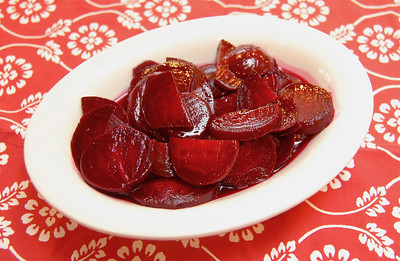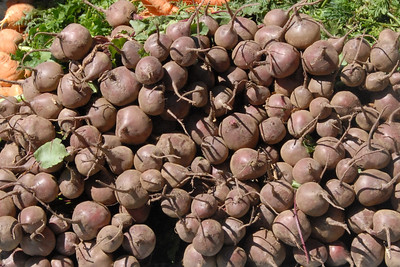As a kid, I thought that beets were the coolest vegetable on the planet. Round, plump and reddish-purple, they possessed a sweet taste and soft, silky texture that I adored. Sweet AND purple! Who wouldn’t love that quirky vegetable?

Today I appreciate these low calorie root veggies not only for their color and taste but also for their versatility. With beets you can cook the leaves as well as the roots. Just steam or saute the greens in garlic and olive oil for a warm salad or side dish. Roast, boil or steam the roots for sides or soups. One vegetable. Multiple recipes and techniques.
Cultivated since 300 B.C., beets are descendants of a wild seashore plant known as the sea beet. This plant grows in clumps along the Mediterranean and Atlantic coastlines of North Africa and Europe. Unlike its offspring, which can be as small as an orange or as large as a grapefruit, it has a small, skinny root.
Thin or fat, beet roots have long been used in salads and soups. Seventeenth century British cooks served cold salads of boiled and sliced beets. Polish chefs featured grated beets in the chilled soup chlodnik while Eastern Europe as a whole is credited with creating the most famous beet soup, borscht.

When working with beets, I follow a few basic rules. I look for fresh, dark green leaves and firm, round, unblemished roots. The roots should range in size from 1 1/2 to 3 inches in diameter. Larger ones tend to be woody and take a long time to cook. Although beets are available year-round, they’re at their peek from summer to early winter.
Back in my kitchen I cut off the greens, stuff them in a perforated, plastic bag and refrigerate them for up to two days. Unwashed and refrigerated, the roots will keep for three weeks.
Although I do wash beets, I never cut or peel them before cooking. If I did, much of the color and nutrients would leach out.
After I’ve boiled, roasted or steamed them, I pull on a pair of rubber gloves, remove the skins and start cutting. If I don’t wear gloves, my hands will turn a lovely crimson color. Pretty to see but it might make people wonder what I’ve been doing. Cooking beets, maybe?
HARVARD BEETS
Serves 4 to 6
For as long as I can recall, I’ve loved Harvard beets. Although my mom’s always came from a jar, I’ve discovered that making them from scratch is almost as easy as and even more delicious than store-bought.
1 1/2 pounds small to medium sized beets, washed
1/2 cup plus 1 tablespoon granulated sugar
1/4 cup water
1/3 cup cider vinegar
3 teaspoons cornstarch
1 tablespoon unsalted butter
Fill a medium-sized stockpot with cold water and 2 teaspoons salt. Bring the salted water to a boil and add the beets. Cover and cook the beets for 20 to 25 minutes, until tender and easily pierced by a knife. Remove the beets and drop them into a pan of cold water. Allow them to cool before putting on rubber gloves and removing the skins and roots. You should be able to remove the skins with your hands. Slice the beets and place them in a bowl. You will end up with about 3 cups of sliced beets.
In a medium-sized saucepan add the sugar, water, cider vinegar and cornstarch and stir to combine. Bring the ingredients to a boil and, stirring constantly, cook for about 1 minute or until the sauce has thickened. Add the butter and stir until melted. Add the sliced beets and stir to coat them. Simmer the Harvard beets for a few minutes and then serve.